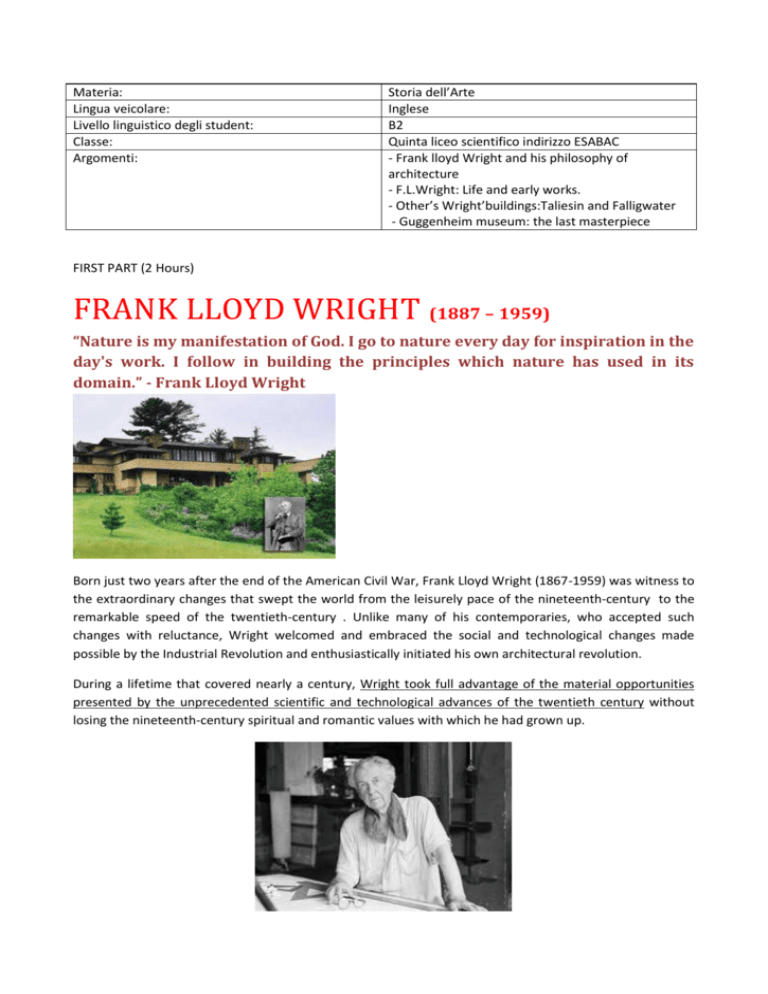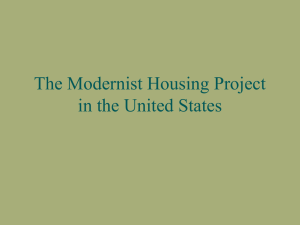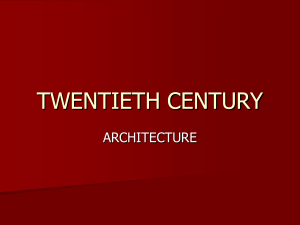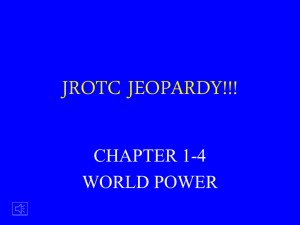Frank Lloyd Wright, An Organic Architecture, 1939
advertisement

Materia: Lingua veicolare: Livello linguistico degli student: Classe: Argomenti: Storia dell’Arte Inglese B2 Quinta liceo scientifico indirizzo ESABAC - Frank lloyd Wright and his philosophy of architecture - F.L.Wright: Life and early works. - Other’s Wright’buildings:Taliesin and Falligwater - Guggenheim museum: the last masterpiece FIRST PART (2 Hours) FRANK LLOYD WRIGHT (1887 – 1959) “Nature is my manifestation of God. I go to nature every day for inspiration in the day's work. I follow in building the principles which nature has used in its domain.” - Frank Lloyd Wright Born just two years after the end of the American Civil War, Frank Lloyd Wright (1867-1959) was witness to the extraordinary changes that swept the world from the leisurely pace of the nineteenth-century to the remarkable speed of the twentieth-century . Unlike many of his contemporaries, who accepted such changes with reluctance, Wright welcomed and embraced the social and technological changes made possible by the Industrial Revolution and enthusiastically initiated his own architectural revolution. During a lifetime that covered nearly a century, Wright took full advantage of the material opportunities presented by the unprecedented scientific and technological advances of the twentieth century without losing the nineteenth-century spiritual and romantic values with which he had grown up. In the process, he transformed the way we live. Dismissing the masquerade of imported historic European styles most Americans favored, his goal was to create an architecture that addressed the individual physical, social, and spiritual needs of the modern American citizen. Each home was uniquely fashioned to meet the needs of its owners and the particular qualities of its location. He called his architecture “organic” and described it as that “great living creative spirit which from generation to generation, from age to age, proceeds, persists, creates, according to the nature of man and his circumstances as they both change.” READ THE ARTICLE ABOUT Frank Lloyd Wright and the principles of Organic architecture by Kimberly Elman ( www.pbs.org/flw/legacy/essay1.html) AND DISCUSS ABOUT IT IN PAIR, LOOKING AT THE PHOTOS. Frank Lloyd Wright and the Principles of Organic Architecture By Kimberly Elman “So here I stand before you preaching organic architecture: declaring organic architecture to be the modern ideal and the teaching so much needed if we are to see the whole of life, and to now serve the whole of life, holding no ‘traditions’ essential to the great TRADITION. Nor cherishing any preconceived form fixing upon us either past, present or future, but—instead—exalting the simple laws of common sense—or of supersense if you prefer—determining form by way of the nature of materials...” — Frank Lloyd Wright, An Organic Architecture, 1939 Frank Lloyd Wright introduced the word ‘organic’ into his philosophy of architecture as early as 1908. It was an extension of the teachings of his mentor Louis Sullivan whose slogan “form follows function” became the mantra of modern architecture. Wright changed this phrase to “form and function are one,” using nature as the best example of this integration. Although the word ‘organic’ in common usage refers to something which has the characteristics of animals or plants, Frank Lloyd Wright’s organic architecture takes on a new meaning. It is not a style of imitation, because he did not claim to be building forms which were representative of nature. Instead, organic architecture is a reinterpretation of nature’s principles as they had been filtered through the intelligent minds of men and women who could then build forms which are more natural than nature itself. Organic architecture involves a respect for the properties of the materials—you don’t twist steel into a flower—and a respect for the harmonious relationship between the form/design and the function of the building (for example, Wright rejected the idea of making a bank look like a Greek temple). Organic architecture is also an attempt to integrate the spaces into a coherent whole: a marriage between the site and the structure and a union between the context and the structure. Throughout his 70 year career, Frank Lloyd Wright published articles, gave lectures, and wrote many books. The philosophy of organic architecture was present consistently in his body of work and the scope of its meaning mirrored the development his architecture. The core of this ideology was always the belief that architecture has an inherent relationship with both its site and its time. When asked in 1939 if there was a way to control a client’s potentially bad taste in selecting housing designs for his Broadacre City project, Wright replied, “Even if he wanted bad ones he could find only good ones because in an organic architecture, that is to say an architecture based upon organic ideals, bad design would be unthinkable.” In this way, the question of style was not important to Frank Lloyd Wright. A building was a product of its place and its time, intimately connected to a particular moment and site— never the result of an imposed style. In 1957, two years before his death, Frank Lloyd Wright published the book, A Testament, which was a philosophical summation of his architectural career. In an essay entitled “The New Architecture: Principles”, he put forth nine principles of architecture that reflected the development of his organic philosophy. The principles addressed ideas about the relationship of the human scale to the landscape, the use of new materials like glass and steel to achieve more spatial architecture, and the development of a building’s architectural “character,” which was his answer to the notion of style. Fallingwater Taliesin West Taliesin Oak park Robie House Below are some of the principles of Wright’s organic architecture. Combine the right letters with numbers A) Building and Site B) Materials C) Shelter D) Space E) Proportion and Scale F) Nature G) Repose H) Ornament I) Simplicity L) Mechanical Systems and Furnishings 1) Organic architecture is simple because its scheme and design are clear. 2) Not all organic architecture has it, but when used, it is developed as an integral part of the material, not applied. Examples are patterns cast in concrete or carved in stone, leaded glass panels, and tile or glass mosaics. 3) These are an integral part of the building: they are not added on, stuck in or unduly exposed. Sculpture and painting have to become elements of the total design. As much furniture as possible should be built-in. 4) The two have a very special relationship in organic architecture. The building grows out of the landscape as naturally as any plant; its relationship to the site is so unique that it would be out of place elsewhere. 5) The creative possibilities of form, color, pattern, texture, proportion, rhythm, and growth are all demonstrated in nature. Organic architecture does not imitate nature but is concerned with natural materials, the site, and the people who will occupy the buildings. 6) These are used simply in a way that enhances their innate character and optimizes their individual color, texture, and strength 7) A building should convey a sense of protection against the elements. Its inhabitants should never lack privacy or feel exposed and unprotected. 8) The human body should be the measure of a building and its furnishings. 9) Quiet, serene, tranquil space is a fitting environment for human growth. It is achieved by simple architectural masses that reflect the uncluttered spaces within and that are carefully related to the site, which reflects the uncluttered space within. 10) An area is never fully comprehended when viewed from one point but must be slowly experienced as one moves through the space. Although these are not all of the principles of Wright’s organic architecture, they outline his general philosophy. Organic design aims to include them, but not even Frank Lloyd Wright achieved them totally in each of his buildings. As Wright himself wrote, “The complete goal of the ideal of organic architecture is never reached. Nor need be. What worthwhile ideal is ever reached?“ FILL THE GAPS Frank Lloyd Wright started not with a style, but with an idea. ______________is primarily an idea - an idea about life, nature, and environment. Architecture represents a wide range of values that have a very direct effect on people's ________. Wright's ________ of architecture was a principle he called 'organic architecture', indigenous of the soil, the time, the place, and of man. Humans are part of nature, subject to the laws, rhythms, and mysteries of nature and happiest if they live in _____________ with it. Their dwellings should reflect this ___________ inside and out. He loved architecture as a romantic and prophetic way of life. Architecture is that great living creative _______________from which generation to generation proceeds, persists, and creates, according to the nature of man and his circumstances. Wright liked oriental and primitive ___________because of their unity with nature, where man could feel his life in an organic whole. In the machine, Wright saw the potential to transform the environment in harmony with_______. Instead, he saw the machine separating man from nature. Wright felt that man should deduce laws of procedure that are inherent in all natural growths for use as basic __________for good buildings. Man is a product of such natural laws. Wright's love of nature inclined him to use natural ___________for the beauty of their natural pattern and texture. Designing a_____________ as an organic entity, it was necessary for building and furniture to be in harmony. Wright was thorough in his concepts of design for a particular project. He would often insist on ____________ not only the building, but also the furniture, flatware, floor coverings, and light fixtures. he used the same principles of organic shape and line - these items should be of the house itself, never just resting upon or within it. Wright stated that the meaning of ornament was the imagination providing a natural pattern to the structure itself. Organic ___________demanded a unity of the ornament with the building, the furnishings, and the site. Wright considered his ______________ living organisms in which all was unified in an architectural whole. If a building is conceived in its organic sense, then all ornamentation is conceived as of the very structure itself. WRIGHT SAYS THAT YOU MUST CONSIDER TWO THINGS WHEN YOU BUILD A HOUSE: PEOPLE’S NEEDS AND THE PARTICULARS OF THE PLACE. DO YOU AGREE WITH HIM? WHAT’S YOUR OPINION? WHY? Write an essay. You can use Writing frames. WRIGHT SPEAKS ABOUT ORGANIC ARCHITECTURE IN THE VIDEO: http://www.youtube.com/watch?v=V3VmhLB7IqM&list=PL98C33F3D6135E027 SECOND PART (2 HOURS) EARLY YEARS Frank Lloyd Wright was born in Wisconsin in 1867. His mother was a teacher and she encouraged him to learn about art, music, and nature. When Wright was nine, his mother gave him a set of Froebel blocks, a children's learning toy by Friedrich FRÖBEL. These consisted of various geometrically shaped blocks that could be assembled in various combination to form three – dimensional composition. Through the blocks, Wright learned to use geometry to create flat designs on paper and to build designs with blocks. As he got older, he started to see geometric shapes in everything around him. Every summer, Wright worked on his uncle's farm. He loved the rolling green hills of the valley where he lived, and he became familiar with the flowers and plants of the Wisconsin prairie. He studied engineering at the University of Wisconsin for a time, but left without a degree. Wright's love of nature remained with him when he moved to Chicago and started working as an architect in 1887. JAPANESE ART Wright was greatly influenced by Japanese art and architecture. Europe was a popular destination for most artists and architects at the time, but in 1905 Wright and his wife Catherine visited Japan instead. Wright took pictures of Japanese temples, waterfalls, and other examples of nature. Throughout his life he said Japanese art inspired him because it eliminated all but the essential elements of any design. Wright asserted that the trip was the invitation of the Emperor, but the real purpose of the trip was to purchase Japanese prints for re-sale to American collectors. During the course of the visit, Wright was contacted by the representatives of the Emperor who informed him of of the Court's wish to replace the old Imperial Hotel in Tokyo built in the 19th century by German investors with a new, deluxe building which would attract foreign visitors to the city. The commission was important to Wright because it gave him the opportunity to design on a grand scale, something which had been denied to him until then. PRAIRIE HOUSES Coonley House, Riverside, Illinois, 1907 Between 1889 and 1909 Wright designed more than 150 buildings, based on the idea that the design of a building should appear to grow from its site and open up a new world to those who live in it. By combining landscape and lifestyle, Wright created houses, called “Prairie houses”, that improved the way his clients lived. Frank Lloyd Wright transformed the American home when he began to design "Prairie" style houses with low horizontal lines and open interior spaces. The floor plans were open and flowing, not boxy and dark. The houses had overhanging roofs to better protect them from bright sun and thunderstorms. There were rows of art glass windows(1) with abstracted designs from nature. They also had huge fireplaces because Wright thought about fireplaces as the heart of the home. Prairie homes can have many shapes: Square, L-shaped, T-shaped, Y-shaped, and even pinwheel-shaped. Furniture was either built-in(2) or specially designed. These homes were called prairie style after Wright's 1901 Ladies Home Journal plan titled, "A Home in a Prairie Town." Prairie houses were designed to blend in with the flat, prairie landscape. (1) row of windows - windows that are part of a line (2) built –in – forming a part of something that cannot be separated from it Famous Prairie Houses by Frank Lloyd Wright 1893: William Winslow Residence River Forest, Illinois. Although this house uses ornamentation in the fashion of Louis Sullivan, it also shows elements of the new Prairie style. The house is a symmetrical rectangle. 1901: Frank W. Thomas House Oak Park, Illinois. Widely considered Wright's first Prairie Style house in Oak Park, and one of his earliest uses of stucco. 1902: Arthur Heurtley House Oak Park, Illinois. This low, compact house has variegated brickwork with vibrant color and rough texture. 1909: Robie Residence This Frank Lloyd house in Chicago is widely considered Wright's finest example of the Prairie style. In the video: http://www.youtube.com/watch?v=Q1xD9DRJNhY we can find something more about the Origins of Prairie School 1893 William Winslow Residence William Winslow Residence, River Forest, Illinois,USA The Winslow House is claimed to be the first Prairie Style house designed by Frank Lloyd Wright because of its design and massing that are similar to the Prairie Style houses Frank Lloyd Wright would design a decade later. It has a low hipped roof; broad central chimney, and severely overhanging roof eaves. The front of the house is completely symmetrical and formal in appearance. Roman brick is the basic material, while stone and plaster are also employed. The half-story space between the cornice topping the brick mass and the widely overhanging roof is filled with heavily textured dark brown terracotta panels. The windows take up the entire space of the terracotta panelling, extending from the cornice to the moulding under the roof. The result is that the roof seems to float above the brick mass, as though it were physically separated from the rest of the structure. Backside view The floor plan of the first (main) floor. THE INTERIOR The interior of the home is just as grand as the exterior, though the interior details are much more ornate. Entering the home, guests are greeted by a grand reception hall with built-in seating. Additionally, the first floor of the home also features the standard elements of any home: a kitchen, dining room and living room with a polygonal bay, as seen in many of his designs of the era. There is also a library and a porch. The buil-in sofas in the dining room The entrance and the fireplace 1901: Frank W. Thomas House Frank W. Thomas House, 210 Forest Avenue, Oak Park, Illinois,USA The house has leaded glass windows, an arched entryway, and a low, long profile. The Thomas house is widely considered Wright's first Prairie Style home in Oak Park. It is also his first all stucco(3) home in Oak Park. Using stucco instead of wood meant that Wright could design clear, geometric forms. (3) – a type of plaster that is used expecially to cover the outside walls of buildings 1902: Arthur Heurtley House Arthur Heurtley House, 318 Forest Ave., Oak Park, Illinois, USA Frank Lloyd Wright designed this Prairie Style Oak Park home for Arthur Heurtley, who was a banker with a keen interest in the arts. The low, compact Heurtly House has variegated brickwork with vibrant color and rough texture. The vast hipped roof, a continuous band of windows along the second story, and a long low brick wall create the sensation that the Heurtley House embraces the earth. 1909: Frederic C. Robie House Robie House, Chicago, Illinois The Frederic C. Robie House in Chicago is widely considered Frank Lloyd Wright's finest example of the Prairie style. It was built in 1909. Originally owned by Frederick C. Robie, a businessman and inventor, the Robie House has a long, low profile with linear white stones and wide, nearly flat roof and overhanging eaves. First floor plan Second floor plan Third floor plan THE INTERIOR Walls of windows, a central fireplace, leaded glass ornamentation, and open, undefined space are elements in the living room of this famous house. The dining room The fireplace and the livingroom The windows Go to http://gowright.org/robie/ . While the furniture from the Robie House was dispersed years ago, and now rests in several public and private collections, this web version of the restoration utilizes photography and digital technology to reunite the furniture with the home. Please enter this virtual restoration to marvel at the extraordinary vision of Wright’s unified design. For more information on Robie House watch the video http://video.about.com/architecture/Characteristics-of-the-Robie-House.htm READING COMPREHENSION - Write TRUE or FALSE near each features To summarize Prairie style houses usually have these features: Low-pitched roof Curtain walls Combination of styles Overhanging eaves Horizontal lines One or more towers Central chimney Open floor plan Timber framing The upper floors project out over the lover ones Clerestory window Roof garden COMPARE ROBIE HOUSE WITH FRANK W. THOMAS HOUSE AND SHOW THE DIFFERECES AND THE SIMILITATITIES IN A VENN DIAGRAM THIRTH PART (3 hours) TALIESIN In 1909 Wright went to Europe with her lover Mamah Borthwick and remained here for two years. When he came back to America from Europe in 1911, he moved to Spring Green, Wisconsin, and built a new home and architectural studio for himself in the rolling hills of his childhood. He called the house Taliesin, which is Welsh for "shining brow." He used materials from the surrounding hills for example, rough flat stone, so the buildings would look like they had sprung from the land. READING COMPREHENSION: Look at the pictures and compare Taliesin house to Prairie Houses. Are there any similitarities? (to do orally in classroom) WATCH THE VIDEO ON TALIESIN WEST http://www.youtube.com/watch?v=H9vC1h0-tI&list=PL98C33F3D6135E027 PUT THE SCRAMBLED SENTENCES IN THE RIGHT ORDER The following sentences go together to form a text about Wright’s house in Arizona. Working in small groups put them in the right order. A)By this time Wright had a large following of students called the Taliesin Fellowship. They would live, work, and study at Taliesin in Wisconsin during the summer and at Taliesin West in Arizona during the winter. B)On weekends, they would have concerts, plays, discussions, and theatrical readings in the theater they designed for the site C)In 1937 Wright bought some land in Arizona and built another home and studio there, which he called Taliesin West. The design of Taliesin West reflects the desert landscape around it. D)Wright's students had to design and build their own cottages because one of Wright's principles was learning about something by doing it. Wright made his students work on the farm just like he did when he was a boy in order to teach them the value and reward of doing something with your hands E) Living and working together was a rewarding experience that the students of Taliesin would remember for the rest of their lives. BUILDINGS WITH BLOCKS Ennis House, 1923 After World War I, Frank Lloyd Wrigh started to think about ways to design houses that more people could afford. Wright experimented with designs made of concrete(4) blocks that were stamped with different patterns. The blocks could be arranged in different ways to create walls and windows. The patterns could be rotated to make interesting designs on the inside and outside. He built four of these "textile block" houses in California based on this idea. They wound up being fairly expensive houses, but he kept thinking about designing affordable architecture based on the repetition of a standard unit. (4)- Concrete is obtained by mixing cement (usually Potrland cement), fine aggregate such as gravel or crushed stone, sand and water. Steel bars can be added to concrete in order to increase its tensile strength and its ability withstand bending forces. FALLINGWATER (1936 – 1939) The so called Fallingwater, was designed in 1936 for the family of Pittsburgh department store owner Edgar J. Kaufmann. He wanted Wright to design a summer retreat for him and his family, a place where they could get away from the dirt and noise of the city and be close to nature. The site, in the woods of Bear Run, Pennsylvania, had a waterfall . Considered by some as the most famous private house ever built, Fallingwater epitomizes man living in harmony with nature. Wright designed the house so that the whole building rests on top of the waterfall and seems to jut out like the rocks and boulders below it, appearing as naturally formed as the rocks, trees and rhododendrons which embrace it. The house is constructed of local sandstone, reinforced concrete, steel and glass. The construction is a series of cantilevered balconies and terraces(6), using stone for all verticals and concrete for the horizontal. (6) cantilevered – something that Juts out/sticks out further than the other things around it The interior of Fallingwater remains true to Frank Lloyd Wright's vision as well, including cantilevered desks, earth-toned built-in sofas, polished stone floors, and large casement windows(7) which allow the outdoors to pour in. built – in sofas (7) casement windows – windows that open like a door with hinges at one side Cantilevered desks The hearth of the soaring stone fireplace is actually a boulder on the hill, supposedly Mr. Kaufmann's favorite sunning spot before Fallingwater was built - the house was literally built around it. From the Great Room a set of stairs enables you to walk down and stand on a tiny platform in the middle of the stream. An other view of the platform He put the bedrooms on the top floor to take advantage of lovely views, so the family would feel like they were living among the treetops. Balconies around several levels of the house allowed the family to rest outside without being away from the comforts of home. READING COMPREHENSION 1)What are the main features of Fallingwater? 2)What are the main building materials ? 3) What does the interior space of Fallingwater look like? IMMAGINE YOU ARE A VIDEO REPORTER. WATCH THE VIDEO ABOUT FALLINGWATER AND COMMENT THE SCENES. (http://www.youtube.com/watch?v=9CVKU3ErrGM) You can talk with the help of a list of phrases or with the help of a list of words that you have prepared before. FOURTH PART ( 3 hour) GUGGENHEIM MUSEUM As Wright got older, he experimented more and more with patterns from nature. In 1956 he designed one of his final buildings, the Guggenheim Museum in New York. The Guggenheim Museum is one of the last structures that Wright designed before his death in 1959. It is the culmination of decades of innovations throughout his architectural career, and shows the progression of his designs from linear to circular. The form of the building is part of Wright's continuing crusade to counteract the right angles that typically dominate architecture. He based the design of the Guggenheim on one shape from nature: the spiral. Wright made no secret of his disenchantment with Guggenheim's choice of New York for his museum: "I can think of several more desirable places in the world to build his great museum," Wright wrote in 1949 to Arthur Holden, "but we will have to try New York." To Wright, the city was overbuilt, overpopulated, and lacked architectural merit. Still, he proceeded with his client's wishes, considering locations on 36th Street, 54th Street, and Park Avenue (all in Manhattan), as well as in the Riverdale section of the Bronx, before settling on the present site on Fifth Avenue between 88th and 89th Streets. Its proximity to Central Park was key; as close to nature as one gets in New York, the park afforded relief from the noise and congestion of the city. His dispensed with the conventional approach to museum design, which led visitors through a series of interconnected rooms and forced them to retrace their steps when exiting. Instead, Wright whisked people to the top of the building via elevator, and led them downward at a leisurely pace on the gentle slope of a continuous ramp. The floor plan is one single fluid ramp spiraling up six stories and resembling the inside of a seashell. In fact it is not divided into individual floors connected by staircases or elevators, but is instead one single fluid ramp spiraling up six stories . A skylight illuminates the interior from above, and the white concrete walls reflect the light. The museum's great rotunda has been the site of many celebrated special exhibitions, while its smaller galleries are devoted to the Guggenheim's renowned collection, which ranges from Impressionism through Contemporary Art. 1)DESCRIBE THE BUILDING USING THE WORDS AND PHRASES SUGGESTED: In New York city – spiral form – central geometry – walking down the – the geometric nature from the structure – the interior to be painted – exibitions – glass dome (to do orally in the classroom) 2)YOU WENT TO NEW YORK AND VISITED THE GUGGENHEIM MUSEUM. Write a mail or a letter to a friend and tell him about your experience, explaining why, in your opinion, this building is so important. You can use Writing frames. CONCLUSIVE TASKS 1) THE GUGGENHEIM IS ONE OF WRIGHT’S FINAL BUILDINGS. CAN YOU SHOW ON A TIMELINE THE MOST IMPORTANT WRIGHT’S BUILDINGS? 2)HOT SEAT. Wright (a student) seats on a chair and answers student’s questions. 3)PREPARE A POSTER ABOUT WRIGHT AND GIVE A PRESENTATION IN CLASSROOM. Work in small group . Use “www.glogster.com”









